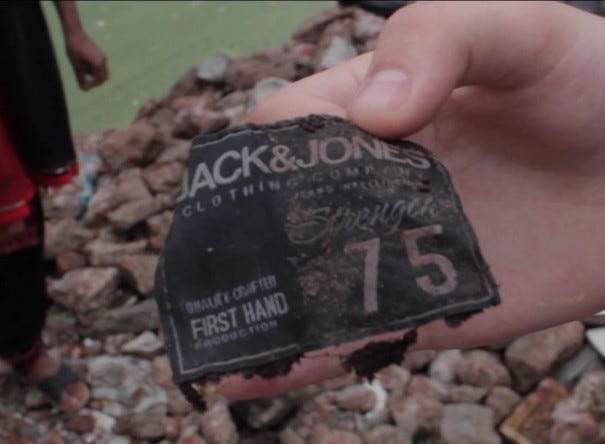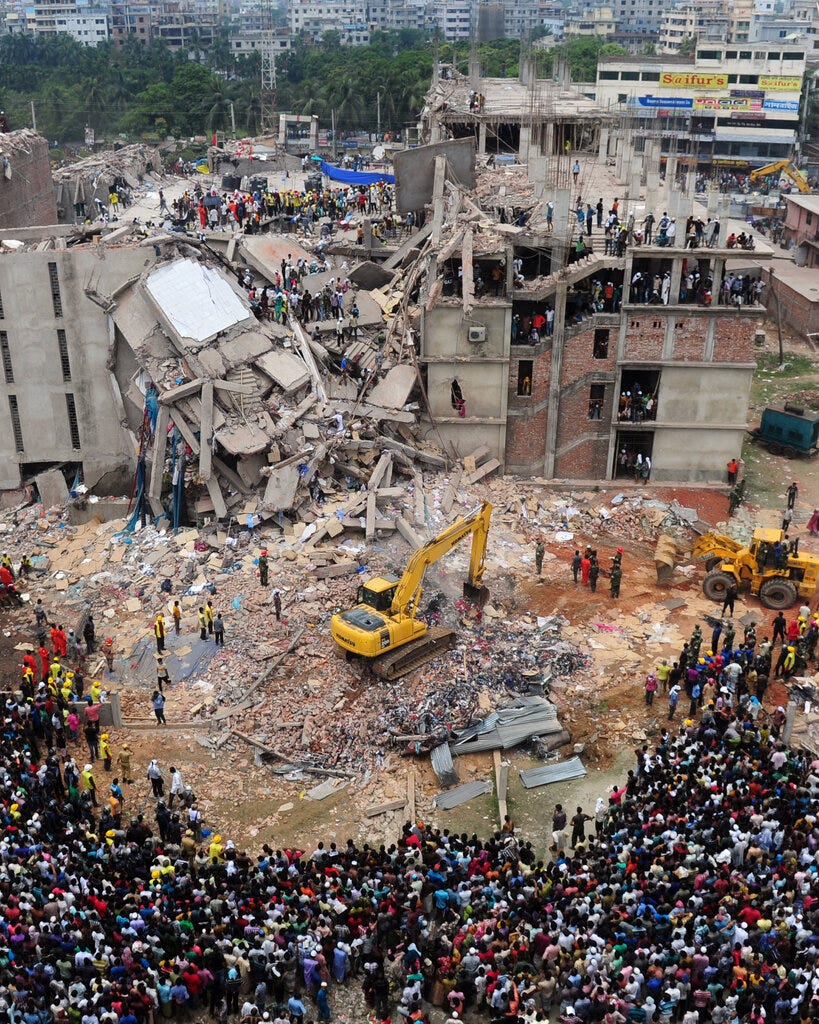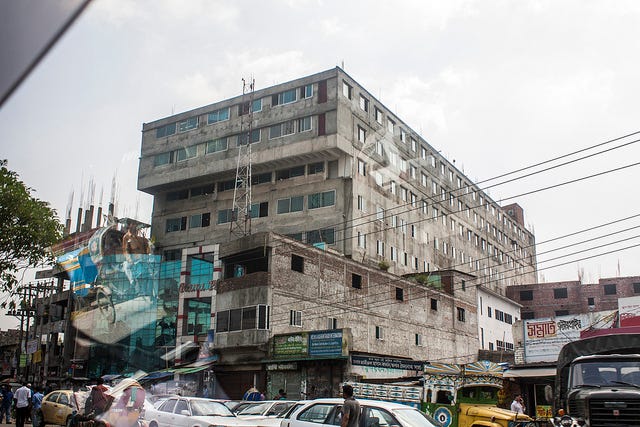The Rana Plaza Disaster
The catastrophic collapse of the Rana Plaza complex claimed thousands of lives. As a departure point for our series on the Bangladeshi garment industry, we trace the story of this fatal disaster.
The Rana Plaza complex in Dhaka, Bangladesh collapsed on April 24, 2013. The bulky nine-storey building, home to five garment factories and a commercial hub of over 300 shops, caved in on itself in a matter of minutes. The collapse of the heavy-set structure was deadly, taking the lives of 1,134 people. Over the course of the following weeks, a panicked and under-resourced rescue mission would attempt to rescue those trapped under a sprawling mass of concrete. By the end of this salvage operation, the injury toll exceeded 2,500.
Most of the victims of the Rana Plaza catastrophe were garment workers who had been working in the factories within the complex. As a result, the disaster - the most deadly structural collapse ever, and the largest industrial incident in Bangladesh’s history - has come to signify a landmark moment for global fashion. Many darlings of the American and European high streets, including Mango, Walmart, and Primark, were implicated in the incident after contracts were found connecting them to the factories, and labels bearing their logos were uncovered in the rubble.

The Rana Plaza disaster is considered - by and large - a turning point in the relationship between the fashion industry’s biggest players, and the rank and file of workers that their clothes are made by. Discursively, it has since become a ‘reckoning point’, a tragic, freak accident that has spurred the industry to adopt safer working conditions and implement transparent supply chains. However, to describe the incident as isolated would be incorrect. Further describing it as a freak accident would be to disregard a pattern of corporate negligence and systemic cost-cutting that precipitated the collapse. And to further describe it as a turning point would be at best a partial obscuring of the continuing reality of the Bangladeshi garment sector. Abuses and injustices continue to plague the workers of Bangladesh’s - and the world’s - garment industry, despite the progress that is alleged to have been made since.
Examining the incident’s causes starts to illuminate how the disaster was made more likely by the exploitative conditions of the global garment industry. Rana Plaza was originally given planning permission to be constructed as a four-storey building. Later, its developers lobbied to extend the building upwards. Sources are contradictory, with some claiming that the extension was illegal, whilst others maintain that the new development was sanctioned by the relevant authorities.
Irrespective, the building essentially doubled in height. The newly-heightened complex sat on unchanged foundations, designed to support a building half its size. Compounding this reckless extension was the conversion of the upper floors from commercial to industrial units. To support the relatively capital-intensive activity of the garment factories (compared to the commercial units of the shopping centre), the developers installed heavy generators high in the complex. The added weight of the industrial equipment - combined with generators’ tendency to vibrate and shake their housings - further weakened the structural integrity of the building.

On the 23rd of April, the day before the disaster, large fissures were found in concrete columns across several floors of the building. These cracks were reported to industrial police who, after inspecting, requested that the building be closed, and any operations suspended by its owners. By-and-large, the commercial units complied, and the ground floor branch of BRAC bank, as well as many of the other shops, were thankfully shuttered on the day of the disaster.
A local news network films inside the Rana Plaza complex the day before the disaster. The large cracks in the masonry are unmistakable. Video: The Guardian
However, the same was not true for the garment factories. Despite the instructions of the industrial police, thousands of garment workers were forced into work by their employers. These workers were aware of the obvious danger, terrified of the risk of collapse, and pleaded with their employers to rethink the decision. Nonetheless, the risk of termination and consequent financial instability led thousands of the mostly-female workers to turn up to work on the day of the accident. Because the events took place in the final week of the month, employers had the additional leverage of withholding the whole month’s salary should their workers fail to report to work. Reports also alleged that workers were physically beaten by their bosses when they expressed their reluctance to enter the building. Furthermore, the front gate of the complex was found locked on the day of collapse, suggesting that the owners of the factory had literally incarcerated their workers in a death trap.
At roughly 8:45AM on the 24th, the building could no longer support its own weight, and collapsed. The middle of the building gave way, with the sides collapsing on the gap that created. The neighbouring three-storey building was also crushed. It is unclear how many of the Plaza’s 5,000-strong workforce were present on the day of the collapse, but the sickening number of casualties suggests that the garment factory owners were successful in coercing their employees into work.

For a detailed account of the incident from the perspective of victims and their families, I recommend this spine-chilling article by Jason Motlagh. It is a very difficult read in places, and contains some horrific detail.
The violently coercive behaviour of these foremen was an extreme form of the exploitation commonplace within the garment industry. Factories ensure their financial survival by competing on (i.e., lowering) prices, and ramping up production to fulfil the condensed timescales demanded by their Western contractors; in turn, this model of immediate production is vital to profiting off ephemeral trends. This is by no means intended to shift the blame from the factory owners and staff who forced their workers into Rana Plaza that day, but rather to capture the market conditions that may have influenced their decisions.
In a series on the Bangladeshi garment industry, it might seem odd to start late in the story. But throughout the coming months, as we explore the past, present, and future of the industry, we will continually return to Rana Plaza, as the apotheosis of its failure to safeguard workers. As we survey the global forces that influenced the industry’s rapid growth, the disproportionate employment of rural middle-class women in its factories, and the gendered politics of the workplace, Rana Plaza’s relevance will become ever clearer.
It is in some ways the fatal extreme of a global industry that cannibalises its workers to ensure its continued expansion. Amidst the rubble of Rana Plaza, we see the evidence of a structural failure: not just the physical inability of the building to support itself; but also the systemic failures of an industry, seemingly indifferent to the well-being of its workers.
Bibliography
Ansary, M.A. and Barua, U., 2015. Workplace safety compliance of RMG industry in Bangladesh: Structural assessment of RMG factory buildings. International Journal of Disaster Risk Reduction, 14, pp.424-437.
Akhter, S., 2014. Endless misery of nimble fingers: The Rana Plaza disaster. Asian Journal of Women's Studies, 20(1), pp.137-147.
Barua, U., Wiersma, J.W.F. and Ansary, M.A., 2021. Can Rana Plaza happen again in Bangladesh?. Safety science, 135, p.105103.
Barua, U. and Ansary, M.A., 2017. Workplace safety in Bangladesh ready-made garment sector: 3 years after the Rana Plaza collapse. International Journal of Occupational Safety and Ergonomics, 23(4), pp.578-583.
Clean Clothes Campaign, 2021. Rana Plaza. Available at: https://cleanclothes.org/campaigns/past/rana-plaza
Kabir, H., Maple, M. and Fatema, S.R. (2018). Vulnerabilities of Women Workers in the Readymade Garment Sector of Bangladesh: A Case Study of Rana Plaza. Journal of International Women's Studies, 19(6), pp. 224-235. Available at: http://vc.bridgew.edu/jiws/vol19/iss6/14
Motlagh, J., 2014. The Ghosts of Rana Plaza. Virginia Quarterly Review. Available at: https://www.vqronline.org/reporting-articles/2014/04/ghosts-rana-plaza





